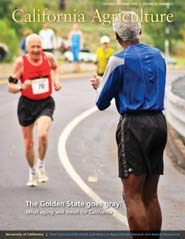Calag Archive
Calag Archive

The Golden State goes gray: What aging will mean for California
Cover:
The first of the baby boomers (born from 1946 through 1964) will reach age 65 in 2011. Aging research in this special issue seeks to improve
the quality of life and wellness of older Californians. Two senior male runners participated in a relay race at Lake Tahoe in June 2009. Photo: Karin Hildebrand Lau/Shutterstock
October-December 2010
Volume 64, Number 4
Volume 64, Number 4


